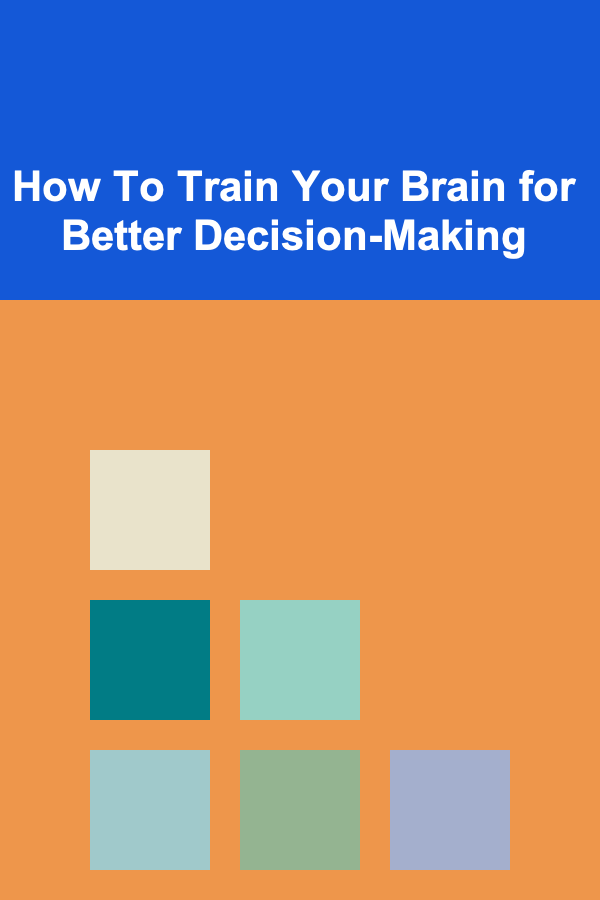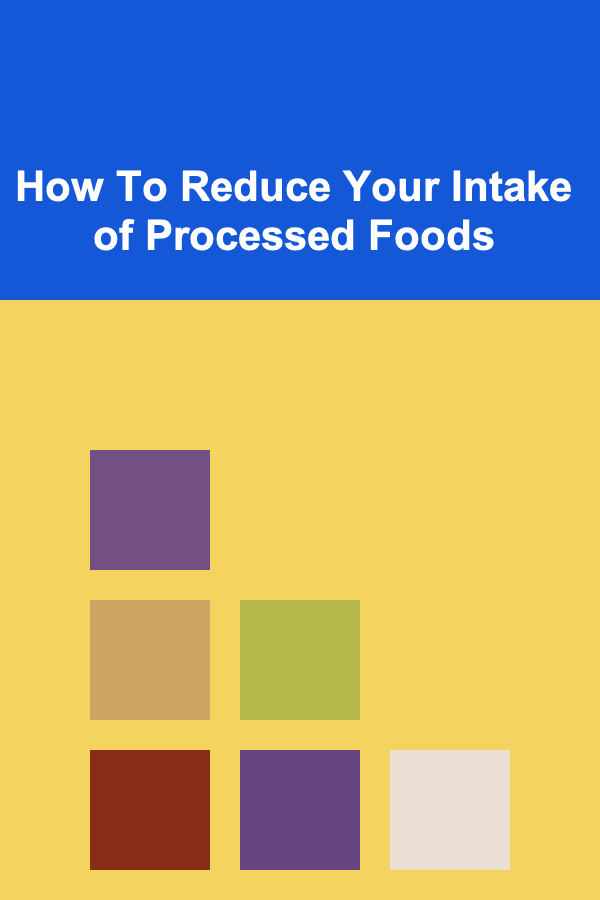
How To Train Your Brain for Better Decision-Making
ebook include PDF & Audio bundle (Micro Guide)
$12.99$7.99
Limited Time Offer! Order within the next:

Decision-making is an inherent part of our daily lives. From mundane tasks such as choosing what to eat for dinner to life-changing choices like selecting a career path, we are constantly making decisions. Yet, many of us struggle with making the "right" choices, often doubting ourselves or second-guessing after the fact. Fortunately, the ability to make better decisions can be trained and improved over time.
In this article, we will explore how to train your brain for better decision-making. We will delve into cognitive biases, the role of emotions, and strategies you can implement to enhance your decision-making abilities. By the end, you'll have a better understanding of how your brain works in the context of decision-making and how to hone this skill to make more thoughtful, deliberate choices.
Understanding the Decision-Making Process
To improve decision-making, it's important first to understand how the brain makes decisions. The brain doesn't make decisions in isolation; it relies on various cognitive processes that shape our judgments and actions.
Cognitive Load
Cognitive load refers to the amount of mental effort required to process information. When faced with too many choices or complex situations, the brain becomes overloaded, making it harder to process relevant information and make informed decisions. The more complex a decision, the more cognitive resources it demands.
To optimize decision-making, reducing cognitive load can be essential. Simplifying choices and minimizing distractions can help the brain process information more efficiently, leading to more rational decisions.
Emotional Influence
Emotions play a significant role in how we make decisions. Often, we may think that emotions cloud our judgment, but they are deeply intertwined with the decision-making process. While emotions can lead to impulsive decisions, they also provide valuable information. For example, fear can prompt us to avoid risky situations, while excitement can push us to seize opportunities.
Learning how to manage emotional influences on decision-making is critical for improving outcomes. While it's impossible to eliminate emotions entirely from the process, being mindful of how they affect your thinking can help you make more balanced decisions.
Cognitive Biases
Cognitive biases are systematic patterns of deviation from norm or rationality in judgment. These biases can lead to illogical conclusions, poor decisions, and reinforce existing beliefs or behaviors. Examples of common cognitive biases include:
- Confirmation Bias: The tendency to seek out information that confirms preexisting beliefs.
- Anchoring Bias: Relying too heavily on the first piece of information encountered when making decisions.
- Overconfidence Bias: Overestimating one's knowledge or ability in decision-making.
Recognizing these biases and actively counteracting them is a key step in improving decision-making. With practice, you can begin to identify when biases are influencing your choices and take steps to mitigate their effects.
Training Your Brain for Better Decision-Making
Now that we understand some of the factors that influence our decisions, let's explore how to train your brain to make better choices. The process of training your brain involves consciously applying certain strategies and techniques to improve decision-making over time.
1. Practice Mindfulness
Mindfulness, the practice of paying focused, non-judgmental attention to the present moment, has been shown to improve cognitive function and decision-making. By being more aware of your thoughts and feelings, you can gain insight into your decision-making processes, recognize emotional triggers, and better manage cognitive biases.
To practice mindfulness in decision-making:
- Take a moment to pause before making a decision.
- Reflect on your feelings and thoughts surrounding the choice.
- Try to observe your internal responses without judgment.
Regular mindfulness practice helps to reduce impulsivity and enhances the ability to make thoughtful, clear-headed decisions.
2. Slow Down Decision-Making
One of the most effective ways to train your brain for better decision-making is to slow down the process. Many decisions, especially in fast-paced environments, are made impulsively or under pressure, which can lead to suboptimal outcomes.
Taking the time to pause and think through your choices allows you to gather more information, consider different perspectives, and evaluate potential outcomes more thoroughly. If you find yourself in a high-pressure situation, taking a few deep breaths or temporarily stepping away from the decision-making process can help you regain clarity and make more rational decisions.
3. Challenge Your Cognitive Biases
As mentioned earlier, cognitive biases can heavily influence our decision-making. The first step to overcoming these biases is awareness. Recognizing when you're falling prey to a particular bias is the first line of defense against it.
For example:
- If you notice you're succumbing to confirmation bias, challenge yourself to seek out contradictory viewpoints and new information.
- If you catch yourself anchoring to an initial piece of information, try to gather a more complete set of data before making a final decision.
Taking deliberate steps to confront biases will allow you to make more informed and balanced decisions.
4. Improve Emotional Regulation
Our emotions often drive decisions, sometimes without us even realizing it. Emotional regulation is the ability to manage and control your emotional responses in a healthy way. The better you are at regulating your emotions, the more rational and clear your decision-making will be.
To improve emotional regulation:
- Practice recognizing your emotional triggers and responding in a composed manner.
- Take breaks when emotions are running high, allowing yourself time to cool down before making decisions.
- Use techniques such as deep breathing or journaling to process emotions before they influence your choices.
Managing your emotional state will help prevent impulsive decisions driven by fear, anger, or excitement and allow for more considered judgments.
5. Consider the Long-Term Consequences
Effective decision-making involves not just thinking about immediate outcomes but also considering the long-term effects of your choices. Often, we focus on the short-term benefits of a decision, such as instant gratification, and overlook the potential long-term consequences.
To train your brain for better decision-making, consciously practice considering the future implications of your choices. Ask yourself questions like:
- How will this decision affect my future goals or well-being?
- What are the potential risks and rewards over time?
Thinking long-term will help you make decisions that align with your broader life objectives rather than reacting impulsively to present circumstances.
6. Diversify Your Decision-Making Approach
Relying on a single approach to decision-making can limit your ability to make well-rounded choices. The most effective decision-makers use a variety of strategies depending on the situation. For example, some decisions may benefit from a logical, analytical approach, while others may require more creative or intuitive thinking.
Experiment with different decision-making methods to find what works best for each type of situation. For example:
- Pros and cons list: Useful for making decisions that are clear-cut and involve tangible factors.
- SWOT analysis: Effective for decisions involving opportunities or risks.
- Gut feeling: Sometimes, intuition can be just as important as logic, especially when faced with uncertainty.
By diversifying your approach, you'll be better equipped to tackle different kinds of decisions with confidence.
7. Learn from Past Decisions
One of the best ways to improve your decision-making is to learn from past experiences. Reflect on previous decisions, both good and bad, and identify what worked and what didn't. This process of self-reflection will allow you to recognize patterns in your decision-making and improve over time.
Ask yourself questions like:
- What factors influenced my decision?
- How did I feel during the decision-making process?
- In hindsight, what would I have done differently?
By incorporating this kind of feedback into your future decisions, you'll gradually train your brain to make more effective choices.
8. Limit Decision Fatigue
Decision fatigue occurs when the brain becomes overwhelmed after making too many decisions. As we go about our day, we make countless small decisions, from what to wear to what to eat. The more decisions we make, the more mentally drained we become, which can lead to poorer choices later on.
To reduce decision fatigue:
- Create routines or habits that reduce the number of daily decisions you need to make.
- Prioritize important decisions earlier in the day when you're mentally fresher.
- Delegate decisions when possible, whether it's choosing a restaurant or letting others take charge of minor choices.
By limiting decision fatigue, you'll be able to approach important decisions with greater mental clarity and focus.
Conclusion
Training your brain for better decision-making requires intention and practice. By understanding the cognitive processes behind decision-making, recognizing biases, managing emotions, and employing various strategies, you can significantly improve your ability to make well-informed choices. Remember, decision-making is a skill that can be honed over time, so be patient with yourself and apply these techniques consistently to see real progress. With enough practice, you'll make decisions more confidently, effectively, and with greater long-term success.

How to Add Light Fixtures That Complement Your Home's Decor Style
Read More
How to Make Cheap and Healthy Snack Options That Taste Amazing
Read More
How To Reduce Your Intake of Processed Foods
Read More
How to Soundproof Your Home Against Traffic Noise
Read More
Mastering Public Relations: Advanced Strategies for Effective PR Campaigns and Influence
Read More
How to Organize Your Sticker Collection Like a Pro
Read MoreOther Products

How to Add Light Fixtures That Complement Your Home's Decor Style
Read More
How to Make Cheap and Healthy Snack Options That Taste Amazing
Read More
How To Reduce Your Intake of Processed Foods
Read More
How to Soundproof Your Home Against Traffic Noise
Read More
Mastering Public Relations: Advanced Strategies for Effective PR Campaigns and Influence
Read More